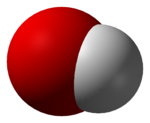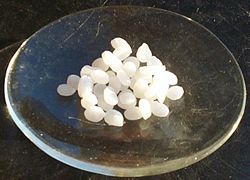Difference between revisions of "Hydroxide" - New World Encyclopedia
({{Paid}}) |
Andy Wilhelm (talk | contribs) (Copyedit) |
||
| Line 1: | Line 1: | ||
| − | {{Claimed}}{{Contracted}}{{Images OK}}{{Submitted}}{{Approved}}{{Paid}} | + | {{Copyedited}}{{Claimed}}{{Contracted}}{{Images OK}}{{Submitted}}{{Approved}}{{Paid}} |
<!-- Here is a table of data; skip past it to edit the text. —> | <!-- Here is a table of data; skip past it to edit the text. —> | ||
{| align="right" border="1" cellspacing="0" cellpadding="3" style="margin: 0 0 0 0.5em; background: #FFFFFF; border-collapse: collapse; border-color: #C0C090;" | {| align="right" border="1" cellspacing="0" cellpadding="3" style="margin: 0 0 0 0.5em; background: #FFFFFF; border-collapse: collapse; border-color: #C0C090;" | ||
| Line 9: | Line 9: | ||
|- | |- | ||
| [[IUPAC nomenclature|Systematic name]]<ref>http://www.iupac.org/reports/provisional/abstract04/RB-prs310804/TableIX-3.04.pdf</ref> | | [[IUPAC nomenclature|Systematic name]]<ref>http://www.iupac.org/reports/provisional/abstract04/RB-prs310804/TableIX-3.04.pdf</ref> | ||
| − | | hydroxide<br>oxidanide<br>hydridooxygenate(1−) | + | | hydroxide<br/>oxidanide<br/>hydridooxygenate(1−) |
|- | |- | ||
| [[Chemical formula|Molecular formula]] | | [[Chemical formula|Molecular formula]] | ||
| Line 20: | Line 20: | ||
| [14280-30-9] | | [14280-30-9] | ||
|- | |- | ||
| − | | {{chembox header}} | <small>Except where noted otherwise, data are given for<br> materials in their [[standard state|standard state (at 25 °C, 100 kPa)]]<br />[[wikipedia:Chemical infobox|Infobox disclaimer and references]]</small> | + | | {{chembox header}} | <small>Except where noted otherwise, data are given for<br/> materials in their [[standard state|standard state (at 25 °C, 100 kPa)]]<br />[[wikipedia:Chemical infobox|Infobox disclaimer and references]]</small> |
|- | |- | ||
|} | |} | ||
[[Image:Sodium hydroxide.jpg|thumb|250px|Pellets of sodium hydroxide.]] | [[Image:Sodium hydroxide.jpg|thumb|250px|Pellets of sodium hydroxide.]] | ||
| − | In [[chemistry]], '''hydroxide''' is the most common name for the [[diatomic]] [[anion]] OH<sup>−</sup>, consisting of [[oxygen]] and [[hydrogen]] [[atom]]s, usually derived from the [[Dissociation (chemistry)|dissociation]] of a [[base (chemistry)|base]]. | + | In [[chemistry]], '''hydroxide''' is the most common name for the [[diatomic]] [[anion]] OH<sup>−</sup>, consisting of [[oxygen]] and [[hydrogen]] [[atom]]s, usually derived from the [[Dissociation (chemistry)|dissociation]] of a [[base (chemistry)|base]]. It is one of the simplest diatomic ions known. |
[[Inorganic]] compounds that contain the [[hydroxyl]] group are referred to as hydroxides. | [[Inorganic]] compounds that contain the [[hydroxyl]] group are referred to as hydroxides. | ||
| Line 38: | Line 38: | ||
Thus, hydroxide ions are heavily involved in [[acid-base]] reactions as well as the special double displacement reaction called [[neutralization]]. | Thus, hydroxide ions are heavily involved in [[acid-base]] reactions as well as the special double displacement reaction called [[neutralization]]. | ||
| − | Salts containing hydroxide are called [[base salts]]. Base salts will dissociate into a cation and one or more hydroxide ions in water, making the solution basic. | + | Salts containing hydroxide are called [[base salts]]. Base salts will dissociate into a cation and one or more hydroxide ions in water, making the solution basic. Base salts will undergo [[neutralisation reactions]] with [[acids]]. In general [[acid-alkali reactions]] can be simplified to |
| − | :OH<sup>−</sup>[[Aqueous|(aq)]] + | + | :OH<sup>−</sup>[[Aqueous|(aq)]] + [[hydronium|H<sup>+</sup>]](aq) → [[water (molecule)|H<sub>2</sub>O]][[liquid|(l)]] |
by omitting [[spectator ion]]s. | by omitting [[spectator ion]]s. | ||
| Line 50: | Line 50: | ||
==Uses of hydroxide== | ==Uses of hydroxide== | ||
| − | Hydroxides and hydroxide ions are relatively common. | + | Hydroxides and hydroxide ions are relatively common. Many useful chemicals and chemical processes involve hydroxides or hydroxide ions. [[Sodium hydroxide]] (lye) is used in industry as a strong base, [[potassium hydroxide]] is used in agriculture, and [[iron hydroxide]] minerals such as [[goethite]] and [[limonite]] have been used as low grade ''brown'' iron [[ore]]. The [[aluminium]] ore [[bauxite]] is composed largely of aluminium hydroxides. |
==Ligand== | ==Ligand== | ||
| − | Hydroxide ion is a kind of [[ligand]]. It donates lone | + | Hydroxide ion is a kind of [[ligand]]. It donates lone pairs of electrons, behaving as a [[Lewis base]]. |
Examples include the aluminate ion [Al(OH)<sub>4</sub>]<sup>−</sup> and aurate ion [Au(OH)<sub>4</sub>]<sup>−</sup>. | Examples include the aluminate ion [Al(OH)<sub>4</sub>]<sup>−</sup> and aurate ion [Au(OH)<sub>4</sub>]<sup>−</sup>. | ||
Revision as of 19:03, 26 September 2007
| Hydroxide | |
|---|---|

| |
| General | |
| Systematic name[1] | hydroxide oxidanide hydridooxygenate(1−) |
| Molecular formula | OH− |
| Molar mass | 19.02 g/mol |
| CAS number | [14280-30-9] |
| Except where noted otherwise, data are given for materials in their standard state (at 25 °C, 100 kPa) Infobox disclaimer and references | |
In chemistry, hydroxide is the most common name for the diatomic anion OH−, consisting of oxygen and hydrogen atoms, usually derived from the dissociation of a base. It is one of the simplest diatomic ions known.
Inorganic compounds that contain the hydroxyl group are referred to as hydroxides.
Hydroxide as a base
Most compounds containing hydroxide are bases.
An Arrhenius base is a substance that produces hydroxide ions when dissolved in aqueous solution. One example would be ammonia (NH3):
- NH3(g) + H2O(l) ⇌ NH4+(aq) + OH−(aq)
Thus, hydroxide ions are heavily involved in acid-base reactions as well as the special double displacement reaction called neutralization.
Salts containing hydroxide are called base salts. Base salts will dissociate into a cation and one or more hydroxide ions in water, making the solution basic. Base salts will undergo neutralisation reactions with acids. In general acid-alkali reactions can be simplified to
by omitting spectator ions.
Solubility
Most inorganic hydroxide salts are insoluble in water, except for cations of alkali metals and the cations NH4+, Ba2+, Sr2+, Ca2+ or Tl+.
Uses of hydroxide
Hydroxides and hydroxide ions are relatively common. Many useful chemicals and chemical processes involve hydroxides or hydroxide ions. Sodium hydroxide (lye) is used in industry as a strong base, potassium hydroxide is used in agriculture, and iron hydroxide minerals such as goethite and limonite have been used as low grade brown iron ore. The aluminium ore bauxite is composed largely of aluminium hydroxides.
Ligand
Hydroxide ion is a kind of ligand. It donates lone pairs of electrons, behaving as a Lewis base. Examples include the aluminate ion [Al(OH)4]− and aurate ion [Au(OH)4]−.
See also
- Hydronium
- Oxide
- Hydroxyl
Notes
ReferencesISBN links support NWE through referral fees
<<Refs needed>>
Credits
New World Encyclopedia writers and editors rewrote and completed the Wikipedia article in accordance with New World Encyclopedia standards. This article abides by terms of the Creative Commons CC-by-sa 3.0 License (CC-by-sa), which may be used and disseminated with proper attribution. Credit is due under the terms of this license that can reference both the New World Encyclopedia contributors and the selfless volunteer contributors of the Wikimedia Foundation. To cite this article click here for a list of acceptable citing formats.The history of earlier contributions by wikipedians is accessible to researchers here:
The history of this article since it was imported to New World Encyclopedia:
Note: Some restrictions may apply to use of individual images which are separately licensed.
